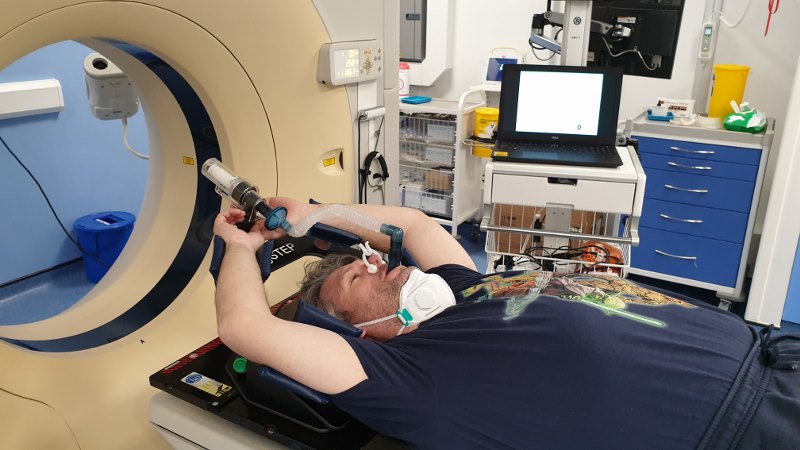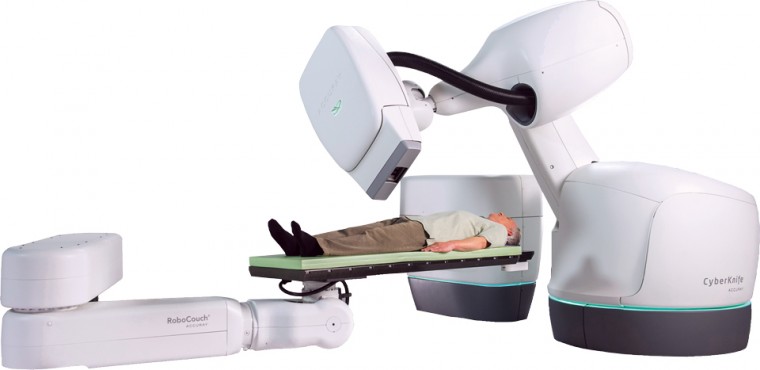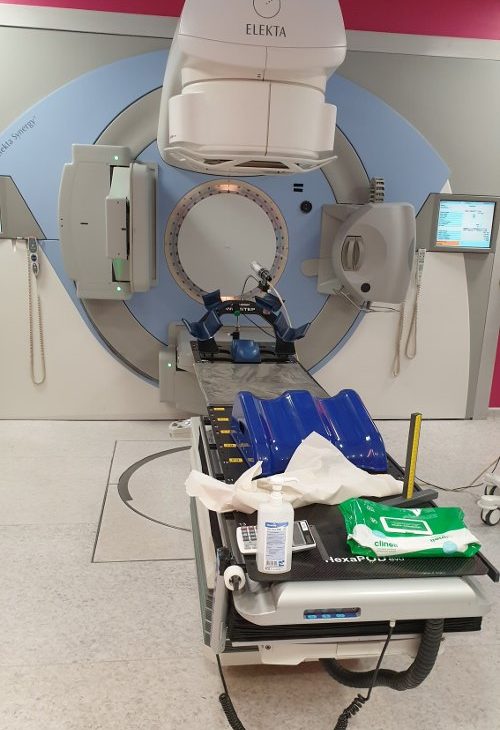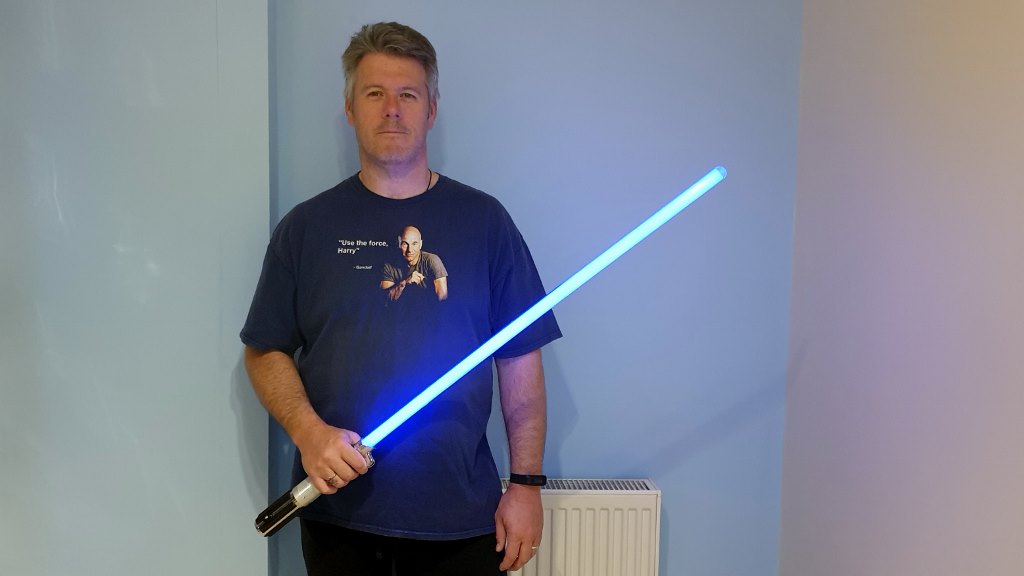In February 2020 my scan results revealed that I had a tumour on Lobe 2 of my liver, and thus began my fourth recurrence. The location of this particular tumour was close enough to one of the major blood vessels of the liver to cause concern in my surgeon. He suggested that we should proceed with surgery as quickly as possible. However, in the UK, the Coronavirus Lockdown put an end to cancer surgeries, which took that option off the table. I got lucky, and was offered SABR Radiotherapy as an alternative.
SABR Radiotherapy is a Radiosurgery technique that uses external radiation. The external radiation is delivered by a machine that moves around your body, while it treats you. This process actually has a number of names, depending on the part of the body it is being used to treat:
- SRS – Stereotactic Radiosurgery, is the generic name for radiotherapy that uses a 3D imaging system. This name is primarily used when the target is the brain
- SBRT – Stereotactic Body Radiation Therapy, is the treatment for the central nervous system in the body
- SABR – Stereotactic Ablative Radiotherapy, is for treatment of areas other than the central nervous system
Because my tumour was in my liver, the radiotherapy that I received was called SABR. As such, this is the name I will typically use throughout this post. Much of what I say, however, will be directly applicable to other variants.
More specifically, the treatment that I received was called ABC SABR. Which translates to, Active Breathing Control Stereotactic Ablative Radiotherapy. And what that actually means, is that I had to hold my breath while the machine revolved, and delivered its treatment.
I went into detail of my personal experiences with SABR Radiotherapy in my May 2020 Progress Update. As such, I won’t be going into such specifics in this post, because the object, here, is to explain the general principles and processes.
Perhaps the best place to start is with how SABR Radiotherapy works. The MacMillan Cancer Support site puts it like this: “Radiotherapy uses high-energy rays, such as x-rays, to treat cancer. It destroys cancer cells in the area where the radiotherapy is given. It aims to stop the cancer cells growing and either shrink the tumour or completely destroy it.”
More specifically:
SABR uses many smaller, thin beams of radiation. The beams are directed from different angles that meet at the tumour. This means that the tumour gets a high dose of radiation, while surrounding healthy tissues get a much lower dose from the individual beams. This lowers the risk of damage to the normal cells.
https://www.macmillan.org.uk/cancer-information-and-support/treatment/types-of-treatment/radiotherapy/external-beam-radiotherapy/stereotactic-ablative-radiotherapy-sabr
The major benefit of this technique is that it can deliver very high doses of radiation, with extreme precision. Some manufacturers suggest that the accuracy of their machine offers ‘sub-millimetre’ precision (for those not using the metric system, think in terms of a sixteenth of an inch). All of which means that fewer sessions are required, typically in the 1 to 8 session range.
My treatment delivered 50 Grays of radiation, over 5 sessions. From what I could make out, it was preferable that these sessions took place every second day. But, seeing as the treatment wasn’t available over the weekend, this was never going to be achieved. People being offered SABR Radiotherapy should, however, expect that the sessions will be close together.
So, now we know what SABR Radiotherapy is, and how it works, we need to know what it can be used to treat. The related Cancer Research UK page explains that, “This type of radiotherapy is mainly used to treat very small cancers.”
It then offers the following examples:
- cancer in the lung
- cancer that started in the liver or cancer that has spread to the liver
- cancers in the lymph nodes
The NHS University Hospitals Bristol site (where I had my treatment) included the following additional cancer locations:
- Pancreas
- Spleen
All of which tells us that SABR Radiotherapy can be used on a variety of cancers, in an increasing number of locations.
And, given that I was told that SABR Radiotherapy has an 80% success rate, this is good news for all cancer patients.
So, let’s have a look at what’s involved in a SABR Radiotherapy treatment…
Given the complexity of the equipment and the levels of radiation involved, it should come as no surprise that there’s a strong emphasis on advance planning of the treatment. This planning phase is likely to take a good couple of weeks, depending on what is required.
If the treatment is on an arm or a leg, you may need a mould. This is exactly what it sounds like. You go in and a cast is made of the appropriate body part. From this, a mould is constructed to completely secure the limb in place during the sessions. Absolute immobility is often the goal during SABR Radiotherapy.
If you’re having the SRS version of the treatment, which will be on your head, you’re likely to need a mask version of the mould. For full details on how that is done, visit the Masks for Radiotherapy page on the Macmillan site.
Regardless of whether you need a mask, a mould, or neither; all patients undergoing SABR Radiotherapy will need imaging.
To properly plan the treatment, it is essential that the consultants know exactly where the tumour is located within the patient. This is typically done using a CT scan. The CT scan is used as a map to place markers on the patient. The markers stay in place throughout the treatment, and guide the SABR machine to the tumour. These markers come in two forms:
- Metal Markers – These are bits of metal, about the size of a grain of rice, that are placed in the body, close to the tumour. These metal markers are introduced by needle. Anaesthetic and, if necessary, sedatives are used, alongside an ultrasound scan, to allow the tip of the needle to find the perfect spot. Normally 2 or 3 of these metal markers are used.
- Skin Markers – These are small ‘dot’ tattoos that are placed on the body, orientated around the location of the tumour. This is what I had. I was given three tiny tattoos: one on the front of my abdomen and one on each side. They’re barely noticeable; like odd-coloured freckles.
During my visit to get my new tats, I was also given breathing training for the ABC element of my SABR Radiotherapy…

While there are some SABR machines that can track your breathing, the machines at University Hospitals Bristol could not. This meant that I had to remain absolutely still while I was receiving my treatment. And the only real way to keep my liver still, was to hold my breath. Again, the full details of this process are in my May 2020 Progress Update, so I’ll only summarise here.
You lie on the bed with your arms, in cradles, above your head. There is a support under your knees, to keep you comfortable. A hose with a snorkel attachment is put in your mouth and a clip on your nose, so you can only breath through the hose. The hose is attached to a machine, which places a temporary block on the hose, such that air cannot pass in or out. The machine is controlled by the button that’s put in your hand. The hose can only be blocked after you press the button. If you let go of the button, the hose opens up again.
It sounds worse than it is. But there’s no need to worry, you’re always in full control. So, there’s never a need to move your position at any point.
The SABR machine, for example, can’t deliver the treatment if the hose isn’t blocked. This means that if you let go of the button, the treatment stops as well. So, seriously: don’t move your position!
In order to trigger the machine to block the hose, you have to take a deep breath, and then try to breathe all the way out. When your lungs are three-quarters empty, the hose blocks, and stays blocked for a pre-arranged length of time.
That’s what the training is for.
First they check what your lung capacity is, so the machine can work out what three-quarters empty is for you. Then they test to see how long you can hold your breath. Starting at 10 seconds…!
And you know you can hold your breath for 10 seconds, after you’ve just taken a deep breath beforehand.
Then they’ll see if you can hold your breath for any longer. What they’re looking for is a 20 second hold. But 10 seconds is fine, if that’s all you’re comfortable with. If you’re willing and able, you can go as high as a 30 second hold, which just helps speed up the process a bit.
And, every time you’re asked to hold your breath, you’ll be given clear instructions of what is required of you. The operator will also count down the seconds left on your breath hold. They do this every time, so there’s no need to worry about forgetting what you’re supposed to do.
And if, at any time, you feel you can’t hold your breath any longer, just let go of the button and breathe away. Everything will automatically stop in place. Nothing is lost, providing you don’t change your position.
Anyway, that’s an amalgamation of the training process and what to expect during the sessions themselves.

https://aoaalaska.com/our-services/cyberknife/
The actual sessions go like this:
- You’re arranged on the bed, so you line up with the machine’s lasers.
- The snorkel is put in your mouth, the clip on your nose and the button in your hand.
- Everyone leaves the room and they talk to you over the intercom.
- The SABR machine performs a CT scan on you.
- The bed is remotely adjusted to line your markers up perfectly.
- A second CT scan is done to confirm the alignment.
- The SABR machine performs the first half of the treatment.
- Another CT scan might be done to ensure you haven’t moved.
- The second half of the treatment is done.
- The staff return and help you off the bed, and you’re free to go
The method that the SABR machine uses to perform the CT scan and the treatment is the same. It makes one complete rotation around you. How long this rotation takes depends on the task and, I imagine, the dose. In my case, the rotation was faster for the CT scan, compared to the treatment. It took three breath holds for each CT scan, whereas it took four breath holds for each treatment.
That was at 30 second breath holds. If you’re taking shorter breath holds, you will need to hold your breath more times to allow a complete rotation of the machine. It all works out the same in the end.
Typically, though, you should expect each session to take 30 to 45 minutes.
And you will have up to eight sessions in fairly quick succession.
Because of this, the actual damage to the tumour, from all that radiation, doesn’t really take hold until after all of the treatment has finished. Any side effects you experience will likely be at their worst about two weeks after the treatment ends. Said side effects should clear up over the month, or so, that follow.
As was mentioned, above, the technique involved in SABR Radiotherapy means that predominantly only the cancer cells get the radiation. The surrounding cells are largely spared. As a result, side effects are often very light. I, for instance, didn’t have much in the way of general side effects. I did have some specific side effects, due to the location of the tumour in relation to my stomach.
Which is to say, the tumour was right next to my stomach. And, as the cells that line the stomach are very sensitive, I ended up feeling some nausea. This, though, was well controlled by the anti-sickness tablets that I was given.
Other than that, I had no side effects except a bit of tiredness.
And that’s astonishing, when you think about it.
I mean, the SABR Radiotherapy machine rotates completely around your body, firing in a tight beam of powerful radiation. It completely rings your body… If it was a Bond film, with a proper laser, it would literally cut you in half! Yet, I didn’t even get any reddening or itchiness of the skin.

The four arms, at the head of the bed, revolve around you during the treatment.
Which is one of the potential general side effects, that includes:
- feeling tired for a few weeks after you finish treatment
- skin reactions such as red, dry or itchy skin about 10 to 12 days after treatment
- soreness and swelling in the treatment area.
There might be other, more specific, side effects, depending on the location of the tumour and treatment:
- Nausea, if it’s close to the stomach
- Shortness of breath, if it’s close to the lungs
- Difficulty urinating, if it’s close to the prostate
I’m sure you get the idea.
You will, of course, be fully appraised of all this, as part of the planning phase of any SABR Radiotherapy treatment you might have.
Should you wish to really study the ins and outs of SABR Radiotherapy, then you need to look at:
Stereotactic Ablative Body Radiation Therapy (SABR): A Resource
Be warned, though, it’s 137 pages long.
So, that’s SABR Radiotherapy. It’s been my first brush with Radiotherapy, and an interesting way to start my fourth recurrence. It’s always nice to break new ground.
I found the treatment process to be a damn sight easier on me than chemotherapy. As to how effective it is? That I simply don’t know yet. Which is why I found the treatment less reassuring than surgery.
The follow-up for SABR Radiotherapy is scans at: 3, 6, 12, 18 and 24 months. I’m still a few weeks away from that first scan, so it’s case of finger’s crossed. At least I already know that if it wasn’t that effective, I’ll be offered surgery. And, while it’s nice to try new things, at least I know where I am when it comes to surgery…

